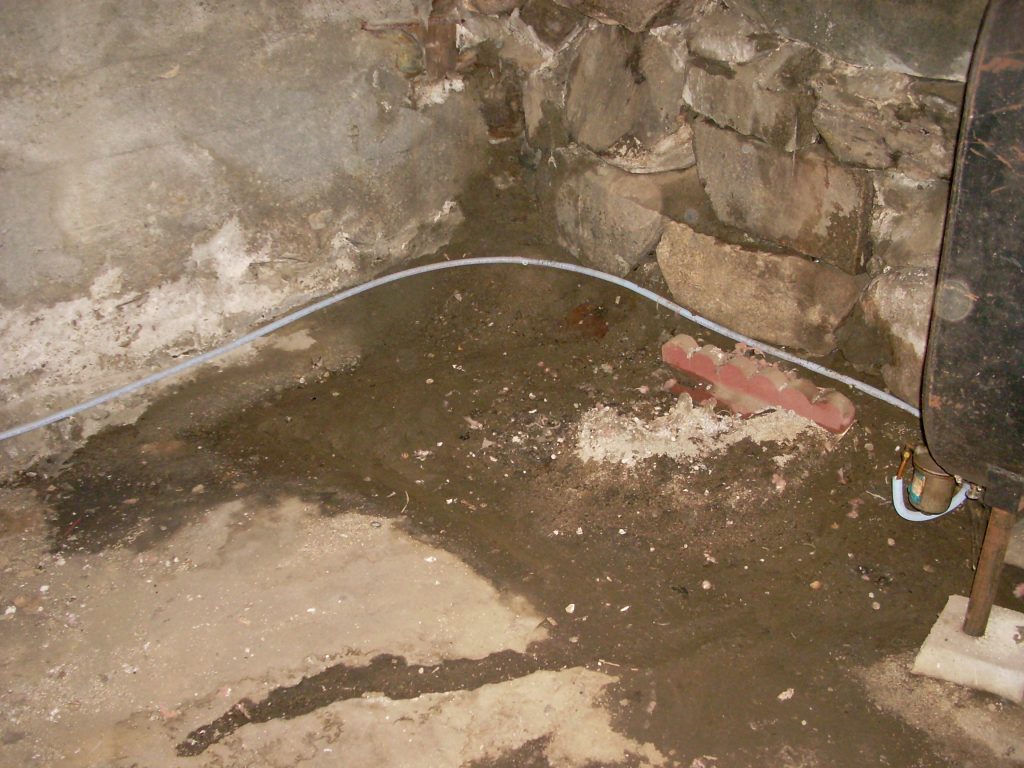
Moisture infiltration is one of the most common problems found in homes and may affect over 90 percent of residential basements at some time or another (Lucy 2013). Moisture leaking through basement walls and floors can cause considerable damage. It can destroy personal possessions stored in a basement. It can cause corrosion to steel structural elements, concrete reinforcing
To understand how moisture gets into basements, you have to know how moisture is supposed to be kept out. The exterior surfaces of a building that keeps moisture from entering comprise what is called the “building envelope”. Historically, building envelope materials were not waterproof. Instead, buildings were designed to shed water during storms and then dry out. The materials used, like wood, stone and, eventually brick, are porous, but when properly detailed will slow moisture infiltration to the extent that intrusion is relatively rare. This approach works, but has limitations; it is not that effective for structures that are continuously in contact with moisture, such as tunnels and deep basements that might be used for underground parking garages. For these applications, waterproofing membranes and other modern materials are used.
Kubal (2008) states two fundamental principles about moisture infiltration. First, 90 percent of moisture infiltration is produced by one percent of the building surface area. Second, 99 percent of leaks are the result of causes other than material failure. What this means is that a small breach in the building envelope, usually at joints will produce a disproportionate share of moisture infiltration. The reason for this is that water travels the path of least resistance. The path of least resistance is usually a joint or connection that is poorly detailed or incorrectly constructed or the result of damage or deterioration.
The building envelope must provide continuous resistance to all sources of external moisture due to precipitation, runoff and even groundwater. That should be self-evident, but even some contractors, architects and engineers fail to detail building envelopes accordingly. In residential construction, a traditional approach to the building envelope is common, consisting of steep roof slopes and water-shedding clapboard siding. When properly detailed this approach keeps moisture out of the building by shedding water and allowing the building envelope to dry. It is not strictly waterproof and impediments to drainage, like ice dams can cause moisture infiltration.
Below ground, soil can be an impediment to drainage and can hold or even direct moisture to the basement walls. A lot of basement are backfilled with poor quality fill, sometimes originating from clay- or silt-containing soil that was previously excavated on-site. These soils drain slowly, retain water and are susceptible to migration, which can result in fouling of footing drains and settlement areas that collect water. In addition surface features, like grading, landscaping, plants and roof drainage can divert water towards the basement walls if improperly constructed or maintained.
Basement walls usually work as moisture barriers, slowing intrusion long enough to prevent infiltration. Crack and joints can provide paths of low resistance resulting in seepage and leaks. There are, of course, other sources of moisture in basements. Leaks of water and sanitary lines are not uncommon. Humidity can condense on cold surfaces, like walls and windows above grade, especially in walk-out basements. If groundwater is relatively shallow and was not accounted for in the design of the basement, moisture can infiltrate from the basement floor.
Many homeowners will call a contractor when they notice something wrong, like leaks, in their home. However, this can be a mistake. A contractor is not necessarily the best person to diagnose a moisture infiltration problem or any other distress. A contractor may know how to complete a repair, but they may not know what to repair in a particular situation. A contractor may be an installer for a particular solution or a product manufacturer that may or may not fix the problem. For example, excavating and installing a waterproofing membrane will be a highly effective, albeit expensive, approach to stopping moisture infiltration through a basement wall. But if the cause of the moisture is high groundwater or missing flashing between a deck and a wall, there will still be water leaking into the basement.
Given that residential basements are often not fully waterproofed, that moisture will infiltrate via the path of least resistance and that multiple potential sources may be the cause of moisture in a basement, it is crucial to first determine why there is moisture in the basement. Because intensive exploration and testing are not typically cost-effective, this determination must rely on informed observation and inference. This requires an underlying fundamental understanding of the mechanics of structural materials, soils and, of course, water. This is a task for an engineer.
An engineer experienced in moisture infiltration issues can do more than just evaluate the likely cause of leaks. He or she can also help develop a cost-effective approach to repair. The repair solution needs to reflect the cause of infiltration, as well as the objective of remediating the infiltration. A variety of waterproofing and drainage approaches are available. If the intent is to simply prevent water from collecting on the floor, the approach will be different then it would be if the basement needs to be dry to create finished space.
Homeowners often suffer “sticker shock” when engaging an engineer. As is the case with lawyers and physicians, engineers’ fees reflect the fact that as licensed professionals, engineers must possess advanced education and experience. It can be hard for homeowners to understand why they should pay hundreds of dollars for an engineer’s visit and a report when a contractor will visit for free and confidently provide an estimate for their solution. But engineering fees are small compared to the cost of completing a repair that does not actually fix the problem.
Engineers cost money, but they add value. Their knowledge and experience applied to a problem can better match the solution with the cause and motivation for solving the problem. This is important for conditions like leaks in basements where the cause may be uncertain and the cost of getting it wrong can be high. The cost of retaining an engineer for a basement moisture infiltration can be money well spent.
The information and statements in this document are for information purposes only and do not comprise the professional advice of the author or create a professional relationship between reader and author.
References:
Kubal, Michael T. Construction Waterproofing Handbook: Second Edition. New York: McGraw Hill: 2008.
Lucy, Ronald O. Water Infiltration into Basements. Forensic Engineering: Damage Assessments for Residential and Commercial Structures, Stephen E. Petty (Ed.). Boca Raton: CRC Press: 2013.

